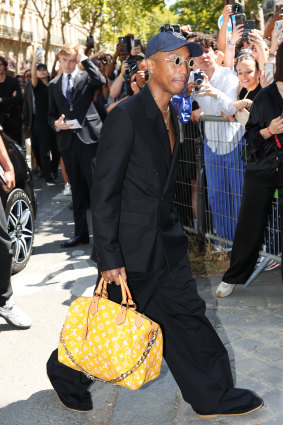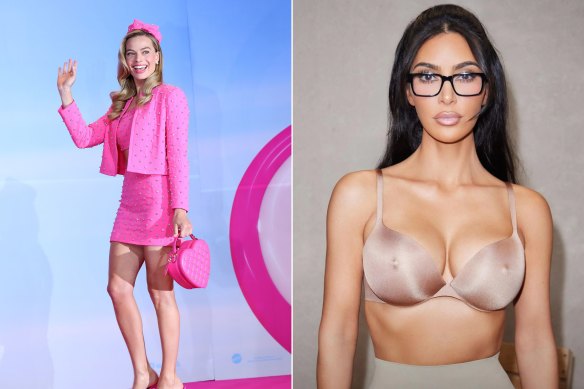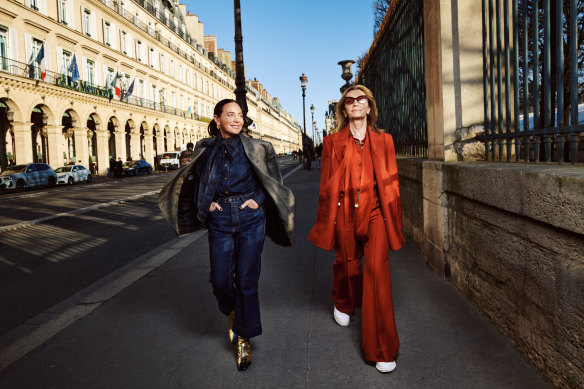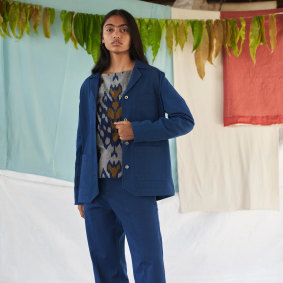This was published 1 year ago
In an era of Barbie pink and nipple bras, one trend keeps me sane
By Marion Hume
How to make sense of the 2023 fashion year that draws to its close with a celebrity designer touting a canary-yellow “millionaire” bag that actually costs $US1 million ($1.55 million)?

Pharrell Williams with Louis Vuitton’s new “Millionaire Speedy” bag that costs … $US1 million.Credit: Getty Images
I’ve interviewed the multi-talented Pharrell Williams a few times, and I’ve been struck by his zeitgeisty intelligence and planetary curiosity. So perhaps I’m especially prickly that the men’s creative director at Louis Vuitton, who is also the singing king of the earworm (Happy, Get Lucky), should seem so cloth-eared on this one?
But then, what does make sense this year? Kim Kardashian’s new bra with built-in nipples? (“So no matter how hot it is, you’ll always look cold,” she says. “… And unlike the icebergs, these aren’t going anywhere.“) Which is both a highly innovative way to draw attention to climate change and, given that her SKIMS shapewear line uses fossil fuel-derived fibres, her complicity in the crisis.
When did fashion get so complicated? It’s enough to make you want to turn back time to when diva editors simply dictated what one wore. “Think Pink!” commanded Broadway star Kay Thompson, channelling legendary fashion editor Diana Vreeland, in 1957’s iconic fashion movie, Funny Face. Ah, but isn’t that what happened this year, when there was no single It-bag, no single It-shoe, but instead a ubiquitous colour, thanks to the blockbuster movie Barbie?

Margot Robbie in the pink in the year’s top colour as Barbie. Kim Kardashian in her new bra “with a built-in nipple”.Credit: Getty Images/Supplied
What a year it’s been for Chanel, whose creative director, Virginie Viard, collaborated on the movie with Chanel brand ambassador Margot Robbie – this success in stark contrast to Mme Chanel’s own experience in 1931, when the Hollywood mogul Samuel Goldwyn paid Coco $US1 million (an epic fee) to costume his movies. The verdict then? Dowdy. “She makes a lady look like a lady. Hollywood wants a lady to look like two ladies,” commented The New Yorker after Coco had spun on her two-tone pumps and headed back to Paris and her distinct brand of exacting chic. And yet it’s this style that’s the subject of a sold-out Chanel show at London’s Victoria & Albert Museum right now.

The brand founded by Nicky (left) and Simone Zimmermann is Australia’s first billion-dollar fashion label.Credit: Antoine Doyen
On to the business blockbuster of the year: of course, it’s Zimmermann becoming Australia’s first billion-dollar fashion label after its private-equity majority acquisition, an event unthinkable when I first spent a lazy day at the beach with sisters Nicky and Simone Zimmermann not long after I moved to Sydney in 1997. How shocked I was, fresh from London, that their swimwear was clearly visible beneath their near-transparent dresses. It won’t catch on, I thought. How wrong I was.
But now, how to get business right when its key driver – growth – is challenged by the planetary necessity of degrowth? Can we do things differently? My favourite fashion show this year brought together charity shop Sue Ryder (the British equivalent of Australia’s Vinnies), the London College of Fashion and – here’s the surprise – the international banking group Lloyds in a glamorous exploration of re-use and reimagining. Black-tie-clad, high-net-worth bank customers cruised a classy pop-up op shop under the chandeliers of one of London’s grandest halls, after which first-year fashion students showed them garments reimagined from second-use materials.
The eternal cliché of fashion – because it happens to be true – is that it’s a fast barometer of social change. This year there’s been a palpable shift from aspiration and consumption towards more conscious purchasing. This has meant my fashion vocab has expanded to include PFAS, the acronym for a group of 15,000 toxic “forever chemicals” that lace far too much of our clothing. I’ve also added “ecocide”, referring to the crime those who wilfully pollute our planet may in the future stand accused of, preferably alongside war and other international crimes in The Hague.
On the upside, the buzzword of the year is “regen”, which is all about recyclability and regenerative agriculture – that is, using fabrics that give more back to the soil than they take. And these garments can be desirable. Many front-line fashion folk found themselves more genuinely excited by the first collection of Oshadi, the pioneering regen label from South India, than by the return, at last, of huge fashion talent Phoebe Philo.

India’s pioneering regen label, Oshadi.
While the first drop under Philo’s own LVMH-backed label sold out, the chatter has been about how out of step it feels to charge customers as much as $1000 for a T-shirt. Personally, I’d rather that a T-shirt was expensive – though not that expensive – than cheap as long as it had ethically sourced fibres woven through it by people paid well for their labour. My views chime with the Gen-Z collaborators with whom I often work. They tend to turn up in pre-loved pieces, I wear my own much-loved pieces; we’re on the same page. On that, the smartphone generation never fails to surprise me with its fascination for my fashion library.
Which brings me to the yellow and pink accessory I’m carrying as we see out the year. I travel around town by “sustainable limo” – aka, the bus. En route, I am dipping into Wear Next by Sydney-based fashion thinker Clare Press. The book has both a joyfully bright cover and a joyfully bright proposition within, which is that a greedy, global business already has all the pathways it needs to change. I’m finding that Press’s views on refashioning the future make far more sense than a million-dollar bag.
To read more from Good Weekend magazine, visit our page at The Sydney Morning Herald, The Age and Brisbane Times.